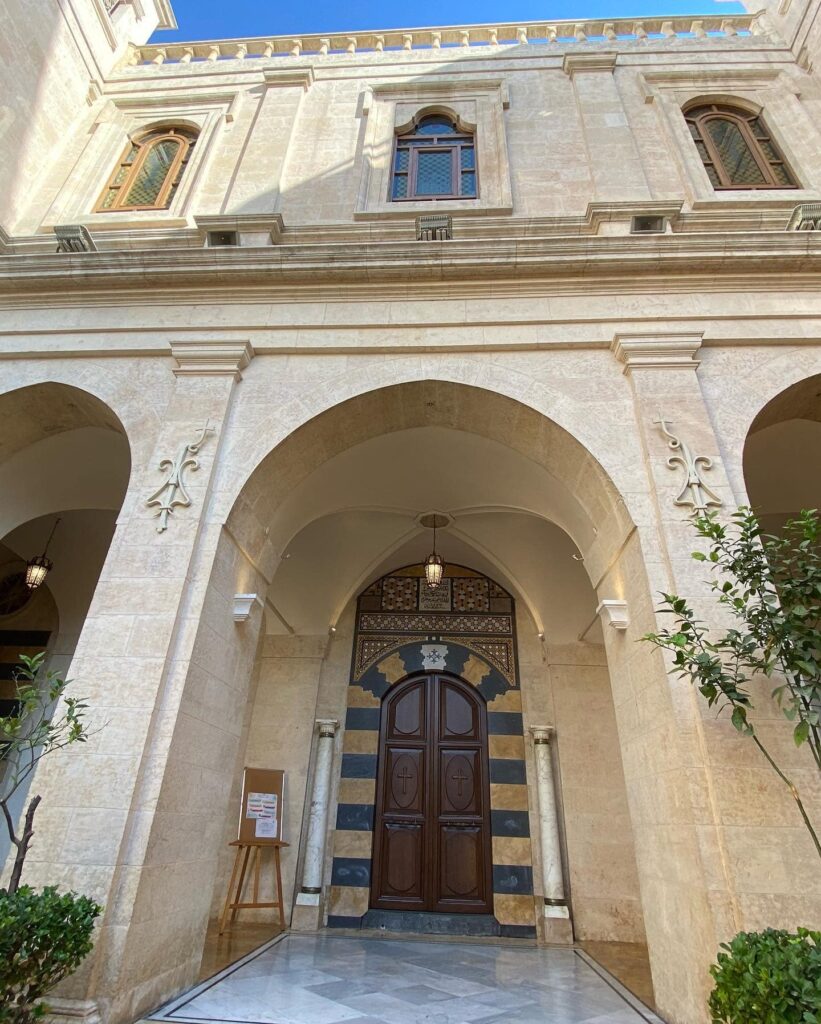Saint Elias Maronite Cathedral: The Historic Center of Maronite Worship in Aleppo
This cathedral serves as the primary place of worship for the Maronite community in Aleppo and is the oldest Maronite church in the city.
It is built from durable yellow stones, known for their resilience and adaptability to various climatic conditions, allowing the structure to endure for long periods.
The church is divided into three longitudinal sections:
The Nave (Sanctuary): The area where the congregation gathers.
The Choir or Bema: Where preliminary prayers take place, including the reading of the Holy Scriptures and supplications.
The Altar: Where the second part of the liturgical service is performed.
Additionally, the church consists of two floors—ground and upper. The altar is a central feature, where the most significant part of the Mass is conducted, which is divided into two segments:
The Word, where the Gospel is read and God’s name is proclaimed.
The Thanksgiving or Sacrifice, in which Christ’s actions are reenacted.
The altar is uniquely adorned with a handcrafted dome, supported by four columns representing the four Gospels, each carrying deep historical and sacred religious symbolism:
The eagle symbolizes John,
The angel represents Matthew,
The ox signifies Luke,
The lion stands for Mark.
Among the church’s distinctive features is the Christ the King stained-glass panel, a one-of-a-kind masterpiece in the East. This rare stained glass has never been used for artwork elsewhere, making this panel truly exceptional. Surrounding it are twelve oil paintings depicting Christ’s Apostles. Additionally, two prominent paintings portray the Virgin Mary and Saint Anthony the Great, each encircled by sixteen monks. These paintings date back to 1852 AD and were created by Rome’s greatest artists of that era.
At the heart of the church lies its main artwork—a painting of Saint Elias, created by the renowned Belgian artist Father Kinne in 1862 AD.
Another defining characteristic is its dome, which was the first reinforced concrete dome built in Aleppo. Previously constructed from wood, it had deteriorated due to climatic conditions. In 1914 AD, craftsmen restored it using reinforced concrete, a material unfamiliar in Aleppo at the time, leading to its designation as the “Dome Structure.”
Over the years, the church underwent numerous modifications, including restoration and expansion. In 1932 AD, a fourth section was added—the courtyard and twin towers, which house the bell tower and the clock tower. One of these towers contains a Swiss-made mechanical clock, highly accurate and still operational today. Notably, the clock has four faces, allowing it to be viewed from all directions. Positioned between the two towers is a statue of Prophet Elias, crafted in Milan, Italy, specifically for the Saint Elias Maronite Church in Aleppo. The statue was transported to Aleppo alongside the construction of the towers in 1932 AD.
Let me know if you’d like further refinements or additional translations!
The altar is uniquely adorned with a handcrafted dome, supported by four columns representing the four Gospels, each carrying deep historical and sacred religious symbolism:
The eagle symbolizes John,
The angel represents Matthew,
The ox signifies Luke,
The lion stands for Mark.
Among the church’s distinctive features is the Christ the King stained-glass panel, a one-of-a-kind masterpiece in the East. This rare stained glass has never been used for artwork elsewhere, making this panel truly exceptional. Surrounding it are twelve oil paintings depicting Christ’s Apostles. Additionally, two prominent paintings portray the Virgin Mary and Saint Anthony the Great, each encircled by sixteen monks. These paintings date back to 1852 AD and were created by Rome’s greatest artists of that era.
At the heart of the church lies its main artwork—a painting of Saint Elias, created by the renowned Belgian artist Father Kinne in 1862 AD.
Another defining characteristic is its dome, which was the first reinforced concrete
dome built in Aleppo. Previously constructed from wood, it had deteriorated due to climatic conditions. In 1914 AD, craftsmen restored it using reinforced concrete, a material unfamiliar in Aleppo at the time, leading to its designation as the “Dome Structure.”
Over the years, the church underwent numerous modifications, including restoration and expansion. In 1932 AD, a fourth section was added—the courtyard and twin towers, which house the bell tower and the clock tower. One of these towers contains a Swiss-made mechanical clock, highly accurate and still operational today. Notably, the clock has four faces, allowing it to be viewed from all directions. Positioned between the two towers is a statue of Prophet Elias, crafted in Milan, Italy, specifically for the Saint Elias Maronite Church in Aleppo. The statue was transported to Aleppo alongside the construction of the towers in 1932 AD.











